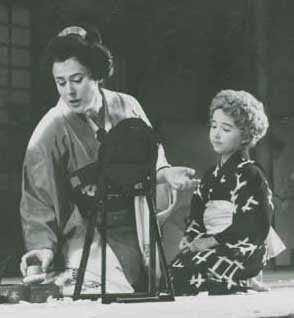Key Word Search
Multi-Field Search
Browse
Repertory Report
Performers Report
Contacts
Met Opera Website
New Production
Madama Butterfly
Metropolitan Opera House, Wed, February 19, 1958
Debut : Eugenio Fernandi, Yoshio Aoyama, Motohiro Nagasaka
Madama Butterfly (356)
Giacomo Puccini | Luigi Illica/ Giuseppe Giacosa
- Cio-Cio-San
- Antonietta Stella
- Pinkerton
- Eugenio Fernandi [Debut]
- Suzuki
- Margaret Roggero
- Sharpless
- Mario Zanasi
- Goro
- Alessio De Paolis
- Bonze
- Ezio Flagello
- Yamadori
- George Cehanovsky
- Dolore
- unknown
- Kate Pinkerton
- Madelaine Chambers
- Commissioner
- Calvin Marsh
- Conductor
- Dimitri Mitropoulos
- Production
- Yoshio Aoyama [Debut]
- Designer
- Motohiro Nagasaka [Debut]
FUNDING:
Production a gift of Cornelius V. Starr
Review 1:
Review of Robert Sabin in the March 1958 issue of Musical America
Visually exquisite and dramatically convincing, the Metropolitan Opera's new production of Puccini's "Madama Butterfly," which had its first performance on Feb. 19, was a resounding success. Not only were the scenery, costumes and stage direction new, but also most of the leading figures in the cast. Eugenio Fernandi made his debut with the company in the role of Pinkerton; Antonietta Stella took the title role for the first time at the Metropolitan; and Mario Zanasi and Ezio Flagello were heard for the first time there as Sharpless and as the Uncle Priest, respectively.
Dimitri Mitropoulos, unfortunately was in a hectic, nervous mood and drove the orchestra and singers unmercifully. But in spite of unstable tempos, distorted phrasing and unbridled climaxes, he did achieve an exciting performance. Luckily, his singers had the stamina to survive a "Götterdämmerung" scale of sonorities and an "Elektra" mood in a Puccini opera.
Since voices come first in opera, let us first consider the singing. Mr. Fernandi has a phenomenally large voice that increases, if anything, in that top range which is the joy of audiences and the fortune of tenors. At this performance, it had more of ringing splendor than Mediterranean warmth and caress, but with the raging sonorities of the pit to deal with, Mr. Fernandi could scarcely devote much energy to delicacy of coloring or subtle shading. His lofty stature and massive build were a distinct advantage, for they made it easier for Miss Stella to project the fragile character of Cio-Cio-San. As to his acting, the less said at this point the better, but he carried himself with dignity and I feel confident that he will be too wise to neglect this aspect of his art, simply because he has a superb voice.
Miss Stella, a lovable and radiant artist, like Tebaldi, had the beauty and power of voice and the dramatic instinct to make Cio-Cio-San wholly a creature of flesh and blood. Marvelously made-up and costumed, she had profited by the stage direction of Yoshio Aoyama so profoundly that her Japanese movements and posture seemed natural. Only in one or two places, notably at the end of "Un bel di", did Mr. Aoyama resort to a stylized pose that seemed to me to be too artificial for the context of the work, which is, after all, fundamentally Italian. (Spaghetti with oriental sauce is still spaghetti.) Miss Stella was particularly gripping in the last act, which is vastly improved in this new production. Cio-Cio-San really commits hara-kiri, instead of cutting her throat, as she did in the bowdlerized versions, and she dies alone, after sending her child out to play in the garden.
As Sharpless, Mario Zanasi created a sympathetic character, though, he, too, has his troubles with the overloud orchestra. Even Ezio Flagello's rotund bass voice, one of the most sumptuous to come to the Metropolitan in many a year, was swamped at times. Margaret Roggero has always been an admirable Suzuki and the others in the cast also performed their familiar tasks with new spirit and address: Madelaine Chambers, as Kate Pinkerton; Alessio De Paolis, as Goro; George Cehanovsky, as Yamadori; and Calvin Marsh, as the Imperial Commissary.
The sets and costumes by Motohiro Nagasaka were a delight in every detail. Each object was visualized and created for its own sake, while fitting into a harmonious whole. The set for Acts II and III, in particular, was a Japanese print come to life. Intoxicatingly fresh were some of the color combinations, such as apple green and lilac blue of Butterfly's relatives. The passionate love scene at the end of Act I no longer seemed to be taking place at Coney Island. And everywhere were cherry blossoms-lovely, fragile blossoms and branches and not clumps of crepe paper pasted on the scenery.
Wisely, Yoshio Aoyama did not attempt to go too far in his stage direction. Japanese life and art were tactfully evoked, but never in a way that overtaxed the abilities of the singers and dancers. Even the little fan dance in Act I was modestly and successfully handled. Yet one felt much closer to Japan than one possibly could have in a production in Western hands. Charles Elson acted as supervisory scenic designer and Ming Cho Lee as supervisory costume designer. It is worthy of note that the scenery was built in the Metropolitan Opera Shops and painted in the Opera Studio and that the blossoms and plants were made by the Universal Flower and Decorating Company. The Japanese costumes were executed in Tokyo.
Production photos of Madama Butterfly by Louis Mélançon/Metropolitan Opera
Search by season: 1957-58
Search by title: Madama Butterfly,
Met careers
- Dimitri Mitropoulos [Conductor]
- Antonietta Stella [Cio-Cio-San]
- Eugenio Fernandi [Pinkerton]
- Margaret Roggero [Suzuki]
- Mario Zanasi [Sharpless]
- Alessio De Paolis [Goro]
- Ezio Flagello [Bonze]
- George Cehanovsky [Yamadori]
- unknown [Dolore]
- Madelaine Chambers [Kate Pinkerton]
- Calvin Marsh [Commissioner]
- Yoshio Aoyama [Production]
- Motohiro Nagasaka [Designer]

